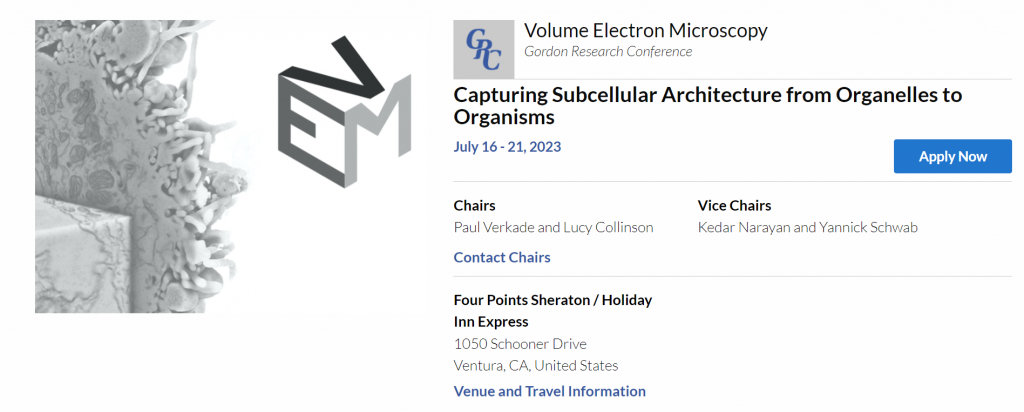https://www.grc.org/volume-electron-microscopy-conference/2023/

he Volume Electron Microscopy GRC is a premier, international scientific conference focused on advancing the frontiers of science through the presentation of cutting-edge and unpublished research, prioritizing time for discussion after each talk and fostering informal interactions among scientists of all career stages. The conference program includes a diverse range of speakers and discussion leaders from institutions and organizations worldwide, concentrating on the latest developments in the field. The conference is five days long and held in a remote location to increase the sense of camaraderie and create scientific communities, with lasting collaborations and friendships. In addition to premier talks, the conference has designated time for poster sessions from individuals of all career stages, and afternoon free time and communal meals allow for informal networking opportunities with leaders in the field.
Just as the resolution revolution in cryoEM has fundamentally altered the field of structural biology, we are entering the era where large-scale and multimodal imaging centered on electron microscopy of cell and tissue ultrastructure in 3D is poised to transform cell biological research. Volume Electron Microscopy (vEM) is a term adopted by our community to describe a set of high-resolution imaging techniques that reveal the three-dimensional structure of cells, tissues and small model organisms at nano- to micrometre resolutions. vEM techniques include Serial Block Face SEM (SBF SEM), Focused Ion Beam SEM (FIB SEM), single-beam array tomography (sAT), multi-beam array tomography (mAT), plasma FIB (pFIB), serial section TEM, serial section Electron Tomography (ssET), and GridTape TEM (gtTEM). Emerging within the past two decades, largely in response to the desire to reconstruct a variety of synaptic features in massive volumes of neuronal tissue, vEM imaging is generally performed at room temperature on resin-embedded cells and tissue samples, with a focus on automation and throughput. Thus, in stark contrast to traditional EM imaging experiments, vEM ‘pipelines’ quickly generate vast amounts of data and depend on significant computational resources. Not only has this required a re-imagining of sample preparation and image acquisition protocols, but vEM has also spawned a whole sub-specialty in computational research devoted to processing, analysis and quantification of rich image datasets to extract meaningful biological insights. Though the volumes imaged in vEM are relatively large in the context of classical electron microscopy, the fundamental trade-off between field of view versus resolution versus speed remains. Further, the incompatibility of EM with live cell imaging has meant that a range of ancillary correlative techniques, including fluorescence microscopy (FM) and X-ray microscopy (XRM), play a critical role to target the event or feature of interest within a larger tissue volume, often a proverbial “needle in the haystack”. Again, in correlative vEM experiments, data-handling and analysis strategies form an integral part of the workflow. This very first GRC on Volume Electron Microscopy aims to bring together this fast-growing community to discuss the latest developments in the field, foster exchange of ideas, and stimulate new collaborations. The condensed and focused form of Gordon Research Conferences is the optimal way to drive this exciting emerging field of technology forward.
